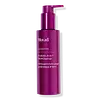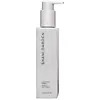What's inside
What's inside
 Key Ingredients
Key Ingredients

 Benefits
Benefits

 Concerns
Concerns

 Ingredients Side-by-side
Ingredients Side-by-side

Water
Skin ConditioningGlycerin
HumectantDecyl Glucoside
CleansingC13-16 Isoparaffin
SolventHexylene Glycol
EmulsifyingPropanediol
SolventHydroxyethyl Acrylate/Sodium Acryloyldimethyl Taurate Copolymer
Emulsion StabilisingLactobacillus
Skin ConditioningAlpha-Glucan Oligosaccharide
CleansingPolymnia Sonchifolia Root Juice
Skin ConditioningXylitol
HumectantXylitylglucoside
HumectantAnhydroxylitol
HumectantSodium Hyaluronate
HumectantSodium Surfactin
CleansingSqualane
EmollientUrea
BufferingYeast Amino Acids
HumectantTrehalose
HumectantInositol
HumectantTaurine
BufferingBetaine
HumectantIsohexadecane
EmollientCaprylhydroxamic Acid
Maltodextrin
Absorbent1,2-Hexanediol
Skin ConditioningPolysorbate 80
EmulsifyingAcrylamide/Sodium Acryloyldimethyltaurate Copolymer
Emulsion StabilisingCitric Acid
BufferingDisodium EDTA
Water, Glycerin, Decyl Glucoside, C13-16 Isoparaffin, Hexylene Glycol, Propanediol, Hydroxyethyl Acrylate/Sodium Acryloyldimethyl Taurate Copolymer, Lactobacillus, Alpha-Glucan Oligosaccharide, Polymnia Sonchifolia Root Juice, Xylitol, Xylitylglucoside, Anhydroxylitol, Sodium Hyaluronate, Sodium Surfactin, Squalane, Urea, Yeast Amino Acids, Trehalose, Inositol, Taurine, Betaine, Isohexadecane, Caprylhydroxamic Acid, Maltodextrin, 1,2-Hexanediol, Polysorbate 80, Acrylamide/Sodium Acryloyldimethyltaurate Copolymer, Citric Acid, Disodium EDTA
Water
Skin ConditioningSodium C14-16 Olefin Sulfonate
CleansingPEG-16 Macadamia Glycerides
EmollientCaprylyl/Capryl Glucoside
CleansingGlycerin
HumectantHydroxypropyl Methylcellulose
Emulsion StabilisingSodium Cocoamphoacetate
CleansingPropanediol
SolventSodium Hyaluronate
HumectantCichorium Intybus Leaf Extract
MaskingAvena Sativa Kernel Extract
AbrasiveOlea Europaea Leaf Extract
PerfumingCocamidopropyl Hydroxysultaine
CleansingSodium Chloride
MaskingXanthan Gum
EmulsifyingPhenethyl Alcohol
MaskingPhenoxyethanol
PreservativeEthylhexylglycerin
Skin ConditioningButylene Glycol
HumectantCitric Acid
BufferingSodium Hydroxide
BufferingHexylene Glycol
EmulsifyingCaprylyl Glycol
EmollientWater, Sodium C14-16 Olefin Sulfonate, PEG-16 Macadamia Glycerides, Caprylyl/Capryl Glucoside, Glycerin, Hydroxypropyl Methylcellulose, Sodium Cocoamphoacetate, Propanediol, Sodium Hyaluronate, Cichorium Intybus Leaf Extract, Avena Sativa Kernel Extract, Olea Europaea Leaf Extract, Cocamidopropyl Hydroxysultaine, Sodium Chloride, Xanthan Gum, Phenethyl Alcohol, Phenoxyethanol, Ethylhexylglycerin, Butylene Glycol, Citric Acid, Sodium Hydroxide, Hexylene Glycol, Caprylyl Glycol
Ingredients Explained
These ingredients are found in both products.
Ingredients higher up in an ingredient list are typically present in a larger amount.
Citric Acid is an alpha hydroxy acid (AHA) naturally found in citrus fruits like oranges, lemons, and limes.
Like other AHAs, citric acid can exfoliate skin by breaking down the bonds that hold dead skin cells together. This helps reveal smoother and brighter skin underneath.
However, this exfoliating effect only happens at high concentrations (20%) which can be hard to find in cosmetic products.
Due to this, citric acid is usually included in small amounts as a pH adjuster. This helps keep products slightly more acidic and compatible with skin's natural pH.
In skincare formulas, citric acid can:
While it can provide some skin benefits, research shows lactic acid and glycolic acid are generally more effective and less irritating exfoliants.
Most citric acid used in skincare today is made by fermenting sugars (usually from molasses). This synthetic version is identical to the natural citrus form but easier to stabilize and use in formulations.
Read more about some other popular AHA's here:
Learn more about Citric AcidGlycerin is already naturally found in your skin. It helps moisturize and protect your skin.
A study from 2016 found glycerin to be more effective as a humectant than AHAs and hyaluronic acid.
As a humectant, it helps the skin stay hydrated by pulling moisture to your skin. The low molecular weight of glycerin allows it to pull moisture into the deeper layers of your skin.
Hydrated skin improves your skin barrier; Your skin barrier helps protect against irritants and bacteria.
Glycerin has also been found to have antimicrobial and antiviral properties. Due to these properties, glycerin is often used in wound and burn treatments.
In cosmetics, glycerin is usually derived from plants such as soybean or palm. However, it can also be sourced from animals, such as tallow or animal fat.
This ingredient is organic, colorless, odorless, and non-toxic.
Glycerin is the name for this ingredient in American English. British English uses Glycerol/Glycerine.
Learn more about GlycerinHexylene Glycol is a surfactant. Glycols are a class of alcohols. Hexylene Glycol is a surfactant and emulsifier.
As a surfactant, Hexylene Glycol helps gather dirt and oil on your skin to be washed away.
As an emulsifier, Hexylene Glycol helps keep water and oil together. This prevents them from separating in a product. Hexylene Glycol also thins out the texture of a product by lessening viscosity.
Hexylene Glycol has a small molecular weight.
Learn more about Hexylene GlycolPropanediol is an all-star ingredient. It softens, hydrates, and smooths the skin.
It’s often used to:
Propanediol is not likely to cause sensitivity and considered safe to use. It is derived from corn or petroleum with a clear color and no scent.
Learn more about PropanediolSodium Hyaluronate is hyaluronic acid's salt form. It is commonly derived from the sodium salt of hyaluronic acid.
Like hyaluronic acid, it is great at holding water and acts as a humectant. This makes it a great skin hydrating ingredient.
Sodium Hyaluronate is naturally occurring in our bodies and is mostly found in eye fluid and joints.
These are some other common types of Hyaluronic Acid:
Learn more about Sodium HyaluronateWater. It's the most common cosmetic ingredient of all. You'll usually see it at the top of ingredient lists, meaning that it makes up the largest part of the product.
So why is it so popular? Water most often acts as a solvent - this means that it helps dissolve other ingredients into the formulation.
You'll also recognize water as that liquid we all need to stay alive. If you see this, drink a glass of water. Stay hydrated!
Learn more about Water